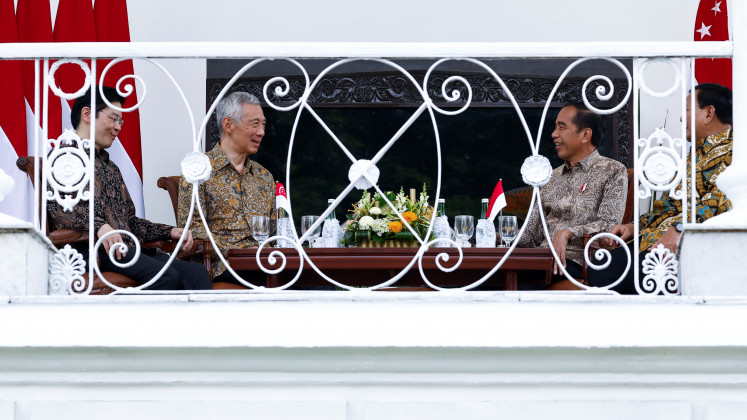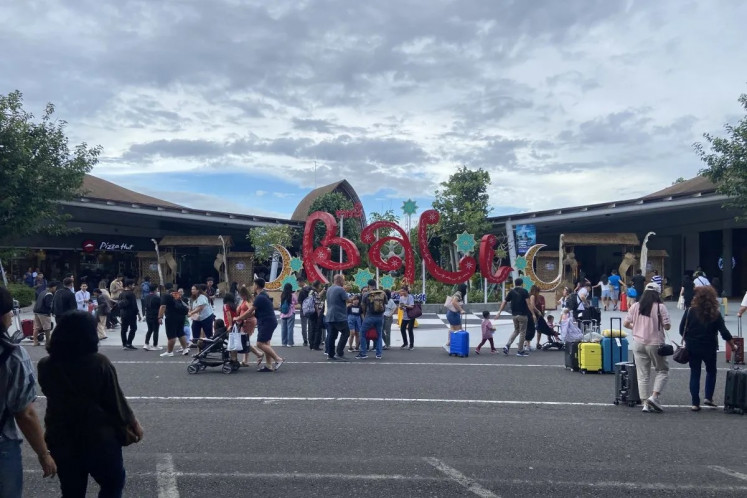From fossilized corals to precious gemstones
Godly creations? A variety of the semi-precious stones are displayed at the “Paintings by Angels: The Amazing Gemstones of Indonesia” exhibition by US award winner designer Irwan
Change Size

G
span class="inline inline-center">Godly creations? A variety of the semi-precious stones are displayed at the “Paintings by Angels: The Amazing Gemstones of Indonesia” exhibition by US award winner designer Irwan. JP/Stanny Angga
At first glance, one might assume that the images of flowers and bouquets adorning the surface of fossilized corals were etched by humans.
In fact, they are natural stones that have been formed over millions of years.
Taken from the seas of Java and Sumatra, these fossilized corals have so far only been found in Indonesia.
The opaque ones, usually of striking color, are mostly found in Java, while the translucent ones, which tend to come in softer colors with smaller flowers, are found in South Sumatra.
Remarkably, the coral stalks of this semi-precious gemstone nearly always look like flowers, and some of the best stones look precisely like a bouquet or even a garden.

These fossilized corals boast various colors ranging from white through cream to yellow, orange and all sorts of reds, even pink, brown, black and green.
Currently, the picturesque corals are abound, but the top quality and unusual pieces are rare and extraordinarily beautiful.
Although the coral has been around for 12 years now, most of the stones found are of poor quality and badly cut.
The fossilized coral was a highlight during the exhibition titled “Painting by Angels: The Amazing Gemstones of Indonesia”, which is hailed as the first ever comprehensive exhibition of Indonesian semi-precious stones.
This exhibition was put together by Irwan Holmes, a US multi award-winning jewelry designer, and included over 1,000 incredible stones and some 300 unique and creative jewels, all from Indonesia.
“Indonesia is so rich in natural resources, and yet much of them are still to be discovered. One of the greatest resources that only few people know about is the remarkable semi-precious stones. In fact, the field of lapidary or stone-cutting work hardly exists here,” said Holmes.
“I have fallen deeply in love with the semi-precious stones of Indonesia – agates and especially the unique fossilized corals that only exist here,” said the man, who has been living in Indonesia for more than 40 years and spent the past five years using Indonesian stones in his designs.
Although not popular overseas yet, Indonesian stones have always bedazzled visitors to every exhibition that Holmes has organized overseas.

To obtain a well-shaped stone, the stone must rubbed down to identify its most attractive part, then cut, sandpapered and polished.
It takes roughly a week for two people to finish 10 pieces of stone.
Twelve of Holmes’ finest designs crafted from various gemstones took center stage in the exhibition, priced at between Rp 3.5 million and Rp 26 million.
“Most of the stones in the finest designs were found in Sukabumi, West Java. People there have started to create more unique pieces from the stones, although they have yet to tap into the global market,” Holmes said.
Landscape (with Roses), which is made of rose agate stone, was the most expensive piece on display.
Other fine agate designs included Chinese Cloud Painting, made of carnelian agate, and the rose-agate Landscape (with mountain), which cost Rp 18 million (US$ 1,900).
Some of the agate designs have unique pictures resembling animals (Head of a Bird and Sleeping Tiger, numbers (Number 8), and the symbol of Allah. These stones are valued at between Rp 3 million to Rp 8 million.
Holmes also exhibited his collection of agate adorned with Chinese-looking writing, and was amazed to discover some of the images actually composed words.
“Some of the writings do have meanings, such as ‘love’, ‘sacrifice’, ‘winter’ and ‘long time’,” he said while pointing out the stones one by one.

The rose agate gems, he said, were only discovered few months ago or so.
“The stone is basically a clear-white-translucent agate but with remarkable fire-engine-red inclusions.”
In a few cases, the red inclusions are shaped like small red tea roses, thus named “rose agate”.
Some of the material is golden brown, which may be less striking than the red, but just as stunning.
In some cases, the inclusions dominate the entire stone, giving it a rich, wild mix of magnificent colors.
“To date, we have enough material for about 100 stones, and there is no certainty we will ever get more. We now consider rose agate to be the most beautiful of all Indonesian semi-precious stones, and perhaps the rarest,” said Holmes.
Holmes also displayed some of his natural green agate collections, usually called chrysoprase in gemological term. The colors range from an attractive pale green to a deep rich emerald green.
Chrysoprase is found in a number of countries, including Australia, South Africa and India. Most of the Australian material has a slightly bluish hue. The country also produces another kind of chrysoprase, a white agate dyed green.
“This is the material you usually find in inexpensive jewelry shops, it is cheap and plentiful, while the genuine natural color [not dyed] chrysoprase is not plentiful and fairly pricey.
“South Africa has a green garnet called ‘South African Jade’, and India an aventurine they like to call ‘Indian Jade’, so we dare to call our natural green chrysoprase ‘Indonesian Jade’”.
Besides agate, there are designs made of assorted jasper stones: Phallus (made of fantasy jasper), Rayban (Hollywood) and the sulphur-jasper Keris Blade, depicting the traditional weapon of Javanese.
Of the 12 finest designs, one is made of panca warna gems, titled Mount Fuji.
Panca warna means “five colors” in Sanskrit, a term used for decades or perhaps centuries to refer to the multi-colored agates and jaspers of Indonesia, more particularly for stones from Garut, West Java.
Panca refers to stones with five colors that command the highest prices. If black and white are counted as colors, these rare and valuable stones could contain five, six, or even seven colors.
“In fact, panca warna gem often contain a lot of black and white, thus showing deep contrast in the colors, which is one of its special features,” Holmes said.
These picturesque panca warna often very expensive, are understandably highly sought after.
— Photos by Stanny Angga









